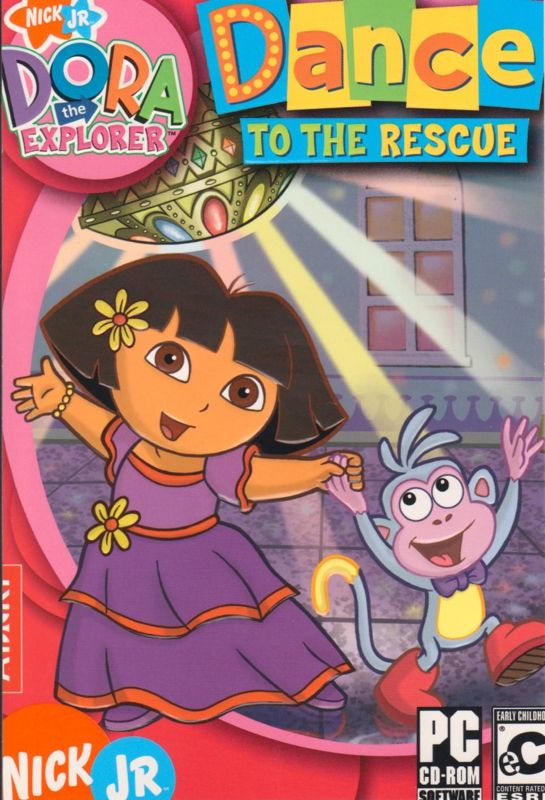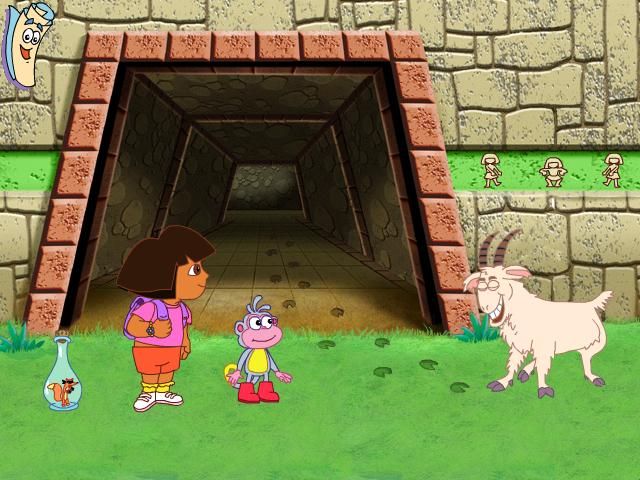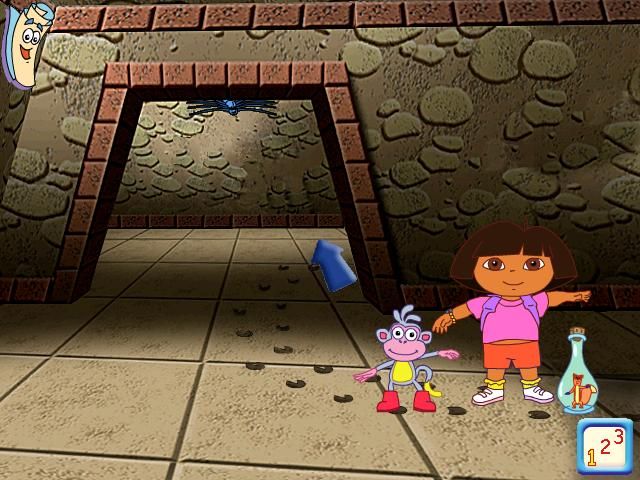Retro Replay Review
Gameplay
Dora the Explorer: Dance to the Rescue offers a simple point-and-click interface that’s perfect for young players stepping into Dora’s world for the first time. From the moment you choose a sticker design and pick your favorite color scheme at the Dance Adventure Center, the game eases children into navigation with clear visual cues and mouse-based interactions. Everything—from selecting a level to exploring new areas—relies on clicking, making it an intuitive experience for preschoolers.
Throughout the adventure, Dora’s constant companions—the map and the level icon—serve dual purposes: guiding players between five distinct locations and allowing them to adjust difficulty on the fly. Switching from an easy rhythm tutorial to a more challenging dance sequence only takes a click, so kids won’t get frustrated if a particular dance move seems tricky. This dynamic level system helps maintain a sense of accomplishment without halting the story flow.
At each destination, players learn a new dance routine by following on-screen prompts and mimicking Dora’s step-by-step sequences. These mini-lessons not only build pattern recognition and memory skills but also introduce young users to basic rhythm concepts. Once all dances are mastered, Dora can enter the King’s dance contest, unlocking a special “One Big Wish” that frees Swiper from the Dancing Elf’s bottle. After completing the main quest, the game even opens up a creative Dance Adventure Center mode, where kids can compose their own dance videos, listen to catchy tracks, and print out dance move sheets for offline fun.
Graphics
The visual style of Dance to the Rescue remains faithful to the beloved animated series, featuring vibrant colors, bold outlines, and character designs that will feel instantly familiar to Dora fans. Backgrounds are richly detailed yet uncluttered, ensuring that young eyes can focus on the interactive elements without distraction. Each location—be it the beach, the jungle, or the castle courtyard—boasts its own color palette and thematic decorations, lending variety to the exploration experience.
Dora and Boots themselves are rendered with cheerful animations that bring their personalities to life. The dance sequences are accompanied by smooth sprite movements that sync well with the upbeat music. Although the animation frames are not as intricate as those in console titles, they strike a fine balance between simplicity and expressiveness, allowing novice players to track every step of the routine.
Special effects—like sparkles when a move is performed correctly or dynamic lighting in the castle ballroom—add excitement and reinforce positive feedback. The user interface elements, including oversized buttons and clearly labeled icons, complement the overall art direction and ensure that the screen never feels too busy. For a CD-ROM title aimed at preschoolers, the graphics hold up admirably and maintain the series’ signature charm.
Story
The narrative of Dance to the Rescue is delightfully straightforward: Swiper the fox has been unwittingly trapped inside a bottle by the Dancing Elf, and it’s up to Dora and Boots to learn a set of dazzling dance moves in order to win the King’s contest and secure the “One Big Wish” needed for his release. This setup provides a clear goal and a sense of urgency that keeps young players engaged without overwhelming them with complex plot twists.
Dora’s bilingual flair shines through in the dialogue—English peppered with Spanish words—reinforcing the educational roots of the television series. Each location visit not only introduces a new dance but also weaves in vocabulary-building moments, prompting children to repeat simple Spanish phrases alongside English instructions. This gentle language immersion aligns perfectly with the brand’s mission to blend fun and learning.
While the story doesn’t delve into deeper emotional arcs or subplots, its simplicity is intentional and suitable for the target audience. The focus remains on positive reinforcement and perseverance—kids must practice each dance to progress, teaching patience and the satisfaction of practice paying off. By the time the final dance contest arrives, players will feel a genuine sense of achievement as Dora finally uses her “One Big Wish” to free her friend Swiper.
Overall Experience
Dora the Explorer: Dance to the Rescue nails its aim of being an accessible, educational, and enjoyable experience for preschoolers. The game’s structure encourages repeated play, as children will want to revisit their favorite locations to perfect dance routines or experiment in the Dance Adventure Center. This replay value extends the title’s longevity well beyond a single playthrough.
Parents and caregivers will appreciate the balanced mix of entertainment and learning. The mouse-driven mechanics foster basic motor skills, while the map navigation and level adjustments introduce early problem-solving concepts. The bilingual dialogue and vocabulary prompts add a subtle language lesson, reinforcing Dora’s series legacy of making education part of the fun.
Despite its modest production values by today’s standards, the game’s tightly focused design and friendly presentation make it a standout among early learning titles. Young children are unlikely to encounter confusing menus or hidden pitfalls; instead, they’ll enjoy a clear, colorful world where every click moves the story forward. Whether you’re a longtime fan of Dora or looking for a safe, engaging introduction to educational software, Dance to the Rescue delivers a delightful adventure.
In conclusion, Dora the Explorer: Dance to the Rescue succeeds in bringing the charm of the TV series into an interactive format that’s both entertaining and educational. Its dance-centric gameplay, faithful art style, and straightforward storyline create a cohesive package that will delight preschool audiences and reassure parents seeking quality children’s software.
 Retro Replay Retro Replay gaming reviews, news, emulation, geek stuff and more!
Retro Replay Retro Replay gaming reviews, news, emulation, geek stuff and more!









Reviews
There are no reviews yet.